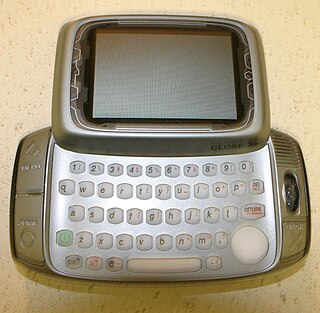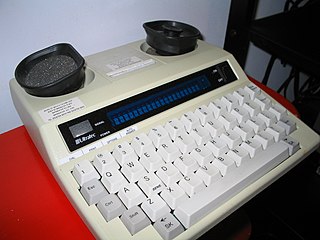
The Danger Hiptop, also re-branded as the T-Mobile Sidekick, Mobiflip and Sharp Jump, is a GPRS/EDGE/UMTS smartphone that was produced by Danger, Inc. from 2002 to 2010.

A telecommunications device for the deaf (TDD) is a teleprinter, an electronic device for text communication over a telephone line, that is designed for use by persons with hearing or speech difficulties. Other names for the device include teletypewriter (TTY), textphone, and minicom.

A telecommunications relay service, also known as TRS, relay service, or IP-relay, or Web-based relay service, is an operator service that allows people who are deaf, hard of hearing, deafblind, or have a speech disorder to place calls to standard telephone users via a keyboard or assistive device. Originally, relay services were designed to be connected through a TDD, teletypewriter (TTY) or other assistive telephone device. Services gradually have expanded to include almost any real-time text capable technology such as a personal computer, laptop, mobile phone, PDA, and many other devices. The first TTY was invented by deaf scientist Robert Weitbrecht in 1964. The first relay service was established in 1974 by Converse Communications of Connecticut.
Interpreting is a translational activity in which one produces a first and final target-language output on the basis of a one-time exposure to an expression in a source language.

The Ground Wave Emergency Network (GWEN) was a US Air Force command and control communications system, deployed briefly between 1992 and 1994, intended for use by the United States government to facilitate military communications before, during and after a nuclear war. Specifically, the GWEN network was intended to survive the effects of an electromagnetic pulse from a high-altitude nuclear explosion and ensure that the United States President or their survivors could issue a launch order to Strategic Air Command bombers by radio.

Midco is a regional cable provider, providing a triple play service of cable television, Internet and telephone service for both North Dakota and South Dakota, along with much of Minnesota, and several communities in Kansas and Wisconsin. The company's business-class service also provides direct fiber-optic communications services via leased data circuits for larger companies.

Videotelephony is the use of audio and video for simultaneous two-way communication.

A video relay service (VRS), also sometimes known as a video interpreting service (VIS), is a video telecommunication service that allows deaf, hard-of-hearing, and speech-impaired (D-HOH-SI) individuals to communicate over video telephones and similar technologies with hearing people in real-time, via a sign language interpreter.
The South Dakota Services for the Deaf (SDSD) is a state agency that supports deaf children in South Dakota. Formerly it was a state-supported school located in Sioux Falls, South Dakota that provided services to meet the educational needs of children who are deaf, hard-of-hearing, or have cochlear implants. SDSD is governed by the South Dakota Board of Regents.

Iowa Wireless Services LLC, doing business as iWireless, was a mobile network operator founded in 1997, not related to Kroger's service. Headquartered in Urbandale, Iowa, iWireless was a partnership between T-Mobile US, Inc. and Iowa Network Services Inc. iWireless owned licenses to operate GSM cellular networks in the PCS-1900 and AWS-1700 radio frequency bands covering Iowa, southwestern Wisconsin and northwestern Illinois. iWireless had over 250 full-service company stores and authorized dealers across Iowa, western Illinois, and eastern Nebraska. iWireless was acquired in full by T-Mobile and on October 1, 2018, the service was shut down as customers were encouraged to migrate to T-Mobile plans.

Video remote interpreting (VRI) is a videotelecommunication service that uses devices such as web cameras or videophones to provide sign language or spoken language interpreting services. This is done through a remote or offsite interpreter, in order to communicate with persons with whom there is a communication barrier. It is similar to a slightly different technology called video relay service, where the parties are each located in different places. VRI is a type of telecommunications relay service (TRS) that is not regulated by the FCC.
The Vermont Center for the Deaf and Hard of Hearing, a non-profit organization, was the primary educational and support services resource for Deaf and Hard of Hearing residents in Vermont and surrounding areas. The Vermont Center, headquartered at Brattleboro’s Austin’s School For The Deaf, was launched by the Austine School in 1998 and operated until 2014. The Austine School was one of four independent schools and twelve outreach programs through which the Vermont Center assisted thousands of Deaf Vermonters.
Telephone interpreting connects human interpreters via telephone to individuals who wish to speak to each other but do not share a common language. The telephone interpreter converts the spoken language from one language to another, enabling listeners and speakers to understand each other. Interpretation over the telephone most often takes place in consecutive mode, which means that the interpreter waits until the speaker finishes an utterance before rendering the interpretation into the other language. As the use of the telephonic modality is increasing it is allowing users to access an interpreter immediately, regardless of time and location.
Dr "Ed" Bosson is best known for his invention of the Video Relay Service which has provided the ability to connect between hearing and deaf communities through the means of video and sign language interpreters. Bosson then went on a long career as an administrator for the Texas Public Utilities Commission (PUC).
An organic minute is defined as the natural state of which telecommunications relay calls are processed between caller and called parties through Communications Assistant that are in conversation mode; that is, no incentives to encourage unnecessary relay minutes.
Total conversation is an ITU standard of simultaneous video, voice and text service in telecommunications. Total conversation allows people in two or more locations to: (a) see each other, (b) hear each other, and (c) conduct a text interaction with each other, or choose to communicate with any combination of those three modes and to do so in real-time.
Assistive Technology for the Deaf and Hard of Hearing is technology built to assist those who are deaf or suffer from hearing loss. Examples of such technology include hearing aids, video relay services, tactile devices, alerting devices and technology for supporting communication.
HASA is a social benefit 501(c)(3) organization located in Baltimore, Maryland, that specializes in facilitating communication. Established in 1926, the organization provides special education services through Gateway School, audiology and speech-language services through its Clinical Services Department, and interpreting services for the deaf through its CIRS Interpreting Department.
Treatment depends on the specific cause if known as well as the extent, type, and configuration of the hearing loss. Most hearing loss results from age and noise, is progressive, and irreversible. There are currently no approved or recommended treatments to restore hearing; it is commonly managed through using hearing aids. A few specific types of hearing loss are amenable to surgical treatment. In other cases, treatment involves addressing underlying pathologies, but any hearing loss incurred may be permanent.

The Edmonton Association of the Deaf (E.A.D.) is an Albertan non-governmental organization that works to promote the interests of the Deaf community in Edmonton, Alberta, Canada.








